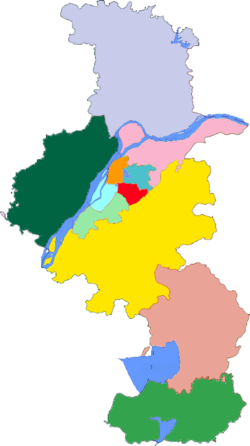Xiao Mausoleum
| Part of | Imperial Tombs of the Ming and Qing Dynasties |
|---|---|
| Criteria | Cultural: (i)(ii)(iii)(iv)(vi) |
| Reference | 1004ter-005 |
| Inscription | 2000 (24th Session) |
| Extensions | 2003, 2004 |
| Area | 116 ha (290 acres) |
| Coordinates | 32°03′30″N 118°50′23″E / 32.058271°N 118.839631°E |
The Ming Xiaoling (
The construction of the mausoleum began during the Hongwu Emperor's life in 1381 and ended in 1405, during the reign of his son the Yongle Emperor, with a huge expenditure of resources involving 100,000 labourers. The original wall of the mausoleum was more than 22.5 kilometres long. The mausoleum was built under heavy guard of 5,000 troops.
Layout and monuments

Great golden gate and Square city
Da Jin Men and Sifangcheng. One enters the site through the monumental Great Golden Gates (Da Jin Men), and is soon faced by a giant stone tortoise (
It is thought that originally the Yongle Emperor planned to install a much bigger stele here. The work on making it was started in the Yangshan Quarry (some 10 kilometres (6.2 mi) east of the mausoleum) in 1405, but the unfinished stele was abandoned in the quarry, as it was realized that it would not be possible to move it.[4]
Unlike the

The Sacred Way
The Sacred Way is an 1,800-metre (5,900 ft)-long road at the Nanjing city Government site. The winding
Lingxing Gate
The Lingxing Gate, a pailou at the end of the Wengzhong Road was destroyed long ago, but rebuilt in 2006.[6]
The central area
One enters the central area of the mausoleum complex through the Wen Wu Fang Men (The Gate of the Civil and the Military). On an inscribed stone tablet outside of the gate is an official notification of the local government in the
Behind the pavilion, there used to be other annexes; however, most of them have collapsed into relics from which the original splendor can still be traced. The emperor and his queen were buried in a clay
The mountain to the south of the tomb, known as Meihua Shan ("Plum Flower Mountain"), is the mausoleum of Sun Quan, King of the Kingdom of Wu in the Three Kingdoms period (220-265). The existence of this tomb is the reason why the Sacred Way is not straight.
Later history
The mausoleum complex suffered damage during the mid-19th century Taiping Civil War, but was restored during the Tongzhi era thereafter.
Along with the
Gallery
-
Da Jin Men (The Great Golden Gates), the main entrance to the site
-
"Elephant Road" (orSpirit Way)
-
The Sifangcheng ("Square City") pavilion
-
A stone lion on the Spirit Way
-
A xiezhi on the "Elephant Road"
-
Camels along the "Elephant Road"
-
Elephants along the "Elephant Road"
-
Qilin along the "Elephant Road"
-
Horses along the "Elephant Road"
-
Statue of a military official on the Spirit Way
-
A civil official on the "Wengzhong Road"
-
Lingxing Gate at the end of the "Wengzhong Road"
-
The Wenwu Fangmen gate
-
The Tablet Hall, with the tortoise left behind by the Kangxi Emperor
-
Inside the Ting Dian ("Pavilion Hall"), which replaces the old Xiaoling Hall
-
Nei Hong Men (The Inner Red Gate)
-
The Soul Tower on top of the Ming Lou
-
The wall surrounding the top of the Lone Dragon Hill, seen from the Soul Tower
-
The annual plum blossom festival is located on Plum Blossom Hill
-
The Shenbo Stove ("The Silk Burner")
The mystery of the third tortoise

In 1999, another, unfinished,
In the meantime, the tortoise and the blank stele (无字碑) have been moved to the Red Chamber Culture Park (红楼艺文苑, Honglou Yiwen Yuan), located just east of the Ming Xiaoling complex.[3][7] The park (which otherwise is a modern Dream-of-the-Red-Chamber-themed landscape and sculpture park) can be visited on the same ticket with the Ming Xiaoling proper.
Notes and references
- ^ Asian Historical Architecture
- ^ 明代帝陵砖材科技含量高 明十九帝陵图片展筹备 Archived 2011-07-20 at the Wayback Machine (High-tech bricks of Ming imperial mausolea: preparing for an exhibition of images of the 19 Ming imperial tombs) Xinhua, 2009-06-10. (Source for sizes)
- ^ a b 明孝陵景区 Archived 2010-01-07 at the Wayback Machine (MIng Xiaoling Scenic Area); at the Nanjing city Government site. (in Chinese)
- ^ Yang & Lu 2001, pp. 616–617
- S2CID 111276325
- ^ Information plaque at the Lingxing Gate
- ^ a b 明孝陵两大“碑石之谜”被破解 Archived 2012-10-18 at the Wayback Machine (Solving the two great riddles of the Ming Xiaoling's stone tablets). People's Daily, 2003-06-13. Quote regarding the Kangxi's stele text and its meaning: "清朝皇帝躬祀明朝皇帝 ... 御书“治隆唐宋”(意思是赞扬朱元璋的功绩超过了唐太宗李世民、宋高祖赵匡胤)"; regarding the dimensions of the stele and its tortoise "康熙御碑孝陵碑殿中部主碑,是清康熙三十八年(1699年)由康熙皇帝爱新觉罗·玄烨所立,高3.85米,宽1.42米,上阴刻楷书“治隆唐宋”4字,字径0.68米,碑座为石制龟趺,高1.06米。"
- ^ Photo and description of the Kangxi's stele. The inscription is interpreted as "His reign was as glorious as that of the Tang and Song"]
Bibliography
- Xiaoling Tomb, Nanjing, China (Asian Historical Architecture – a Photographic Survey) – includes detailed site map and photos. One of their main sources is: Barry Till, with the assistance of Paula Swart. In Search of Old Nanking. Joint Pub. Co. (Hong Kong Branch). 1982. Hong Kong
- Yang, Xinhua (杨新华); Lu, Haiming (卢海鸣) (2001), 南京明清建筑 (Ming and Qing architecture of Nanjing), Nanjing University Press, ISBN 7-305-03669-2
External links
- Virtual Xiaoling Tomb of the Ming Dynasty – VRML modeling of some artifacts






















